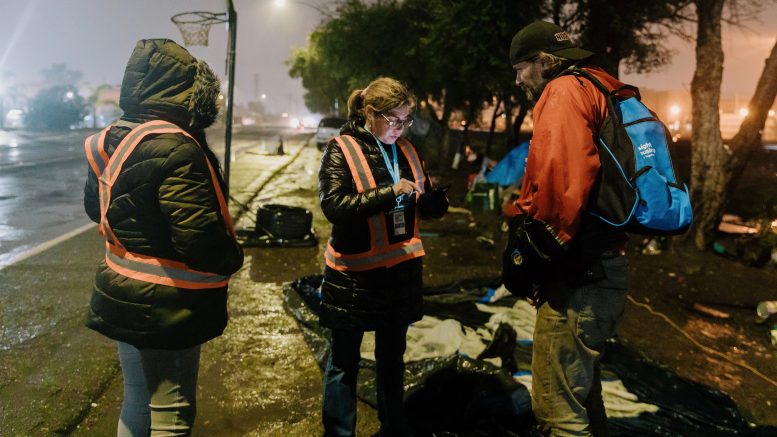By Marie-Elena Schembri
In 2023, the city of Sacramento ranked in the top three U.S. cities for percentage of unsheltered homeless individuals and families and for individuals experiencing chronic homelessness.
The most recent results of Sacramento County’s Point-in-Time Count in 2022 found more than 9,200 people experiencing homelessness in one night, up 67% from 2019. The county’s last PIT Count took place in January, and results will be available later this spring, according to the website.
The data continues to point to a major crisis in the local community.
In response to this crisis, the City of Sacramento, Sacramento County, the nonprofit Sacramento Steps Forward, and the Sacramento Continuum of Care (COC) have pioneered a system that centralizes information and streamlines access to shelter and crisis resources.
Utilizing the 2-1-1 phone number as its primary public interface, the Coordinated Access System (CAS) connects those in need with available shelters and housing programs through a single framework. Previously, individuals had to contact various shelters, agencies or organizations, each with unique intake processes, wait times, resources, and data-entry systems for assistance. CAS acts as “a single front door” to the 14 participating emergency shelters, according to Sacramento Steps Forward Planning Director Peter Bell.
How it works
CAS is a collaborative effort led by Sacramento Steps Forward, the agency responsible for the coordinated entry system, which also manages the HMIS database and leads the Sacramento region’s CoC, a regional board that plans, coordinates and evaluates homeless assistance resources.
“The CAS as a shared regional tool is valuable in two distinct ways,” said Tim Swanson, a spokesperson for the City of Sacramento. “First, it organizes regional resources in one easy-to-access place so they can be deployed effectively by service providers. Second, it gathers critical data that can be used to inform strategic planning. The system also creates an equitable front door for access to shelter by standardizing the entry process and easing geographic restrictions throughout the Continuum of Care.”
Soft-launched in 2022, CAS is an upgrade to the prior coordinated entry system used by service providers to assess, score and prioritize client’s needs. Integrating with the Homeless Management Information System (HMIS) database, which is accessible to trained partner agencies, those in need can easily be placed onto shelter waitlists, approved for emergency shelter or connected with other resources.
Whether assisted by 2-1-1, through outreach teams or a partner agency, a survey assesses the individual or family’s vulnerability factors, prioritizes their needs, and matches them with available services and programs.
Is CAS working?

In December 2023, callers to the new CAS shelter line had a 5.26-minute average call wait time and a 25-day average wait for shelter placement, according to Sacramento Steps Forward’s monthly report. Out of over 4,500 calls in December, 1,137 households were assessed for shelter needs, 156 were enrolled in shelter, 169 were accepted into housing programs, 15 were diverted through other assistance and 268 received crisis referrals.
For Bob Erlenbusch, executive director of the Sacramento Regional Coalition to End Homelessness, who has worked in homeless outreach for 40 years, the results aren’t drastic enough to warrant praise just yet.
“Looking at December’s report, only 14.8% [of all shelter assessments] got into any kind of housing. So it is not helping almost 85% of our unhoused neighbors,” Erlenbusch said.
“The bottom line is that it sounds great to have coordination, but the issue is there isn’t the housing, the affordable housing to place people,” he said.
While CAS may not provide more housing, those working with the system believe it is key to improving the homeless situation in Sacramento.
To Joe Smith, program director of the Homeless Outreach Program at Hope Cooperative and co-chair on the CAS committee of the CoC board, what CAS does well is prevention and intervention.
“[CAS does an] excellent job there [in] really making a difference in keeping people from ending up going any further into the system, maximizing shelter beds and shelter placements,” Smith said, also stating the importance of CAS for garnering insights through data.
“It’s definitely pulled the sheets back on how many people need shelter versus how much shelter capacity [exists],” Smith said, adding that CAS reports provide data to show unmet needs.
Bell reiterated this point, saying, “We now have that opportunity for our community to better understand what homelessness looks like in our community and getting more of that information on who needs support, what kind of support they need, and what resources exist now, and maybe where those continued gaps remain.”
The future of CAS: filling the gaps

Some of the gaps that Bell acknowledged include the lack of adequate shelter, limitations in recuperative care programs for medically vulnerable populations, as well as barriers for those without access to a phone.
To address the last point, two staffed physical access points will be added to the downtown Sacramento area in the spring of 2024, which will accommodate walk-ins and will be well-advertised, according to Bell.
Plans also include the creation of a mobile app designed to help homeless youth and young adults, developed in collaboration with the CoC’s Sacramento Youth Action Board. The app will serve as an additional entry point to CAS, facilitating direct connection to services for youth.
Further enhancements involve broadening language access, increasing community outreach, streamlining housing assessments for CAS’s nearly 50 participating programs, integrating new housing and shelter programs, implementing a rapid response system for highly vulnerable households, reducing waitlist durations for HMIS partners, and enhancing collaboration with community partners currently lacking HMIS access.
While Bell acknowledges the system isn’t perfect, feedback for CAS in its first year has been positive.
“There are always growing pains,” Bell said, “but the consistent theme is that everyone really wants to work together, and I think we all know that ending homelessness requires all of us to work together and to be able to coordinate our activities to the fullest extent possible. In many ways, that’s what CAS was built for.”
This story is part of the Solving Sacramento journalism collaborative. Solving Sacramento is supported by funding from the James Irvine Foundation and James B. McClatchy Foundation. Our partners include California Groundbreakers, Capital Public Radio, Outword, Russian America Media, Sacramento Business Journal, Sacramento News & Review, Sacramento Observer and Univision 19.


Be the first to comment on "Coordinated Access System creates one ‘front door’ for Sacramentans in need of shelter"